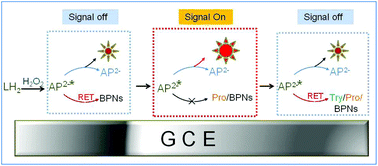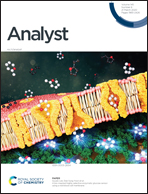Electrochemiluminescence resonance energy transfer between luminol and black phosphorus nanosheets for the detection of trypsin via the “off–on–off” switch mode†
Abstract
In this work, the electrochemiluminescence (ECL) behavior of a luminol–H2O2 system was studied on a black phosphorus nanosheet (BPN) modified electrode. A quenching effect of BPNs on luminol ECL was achieved based on ECL resonance energy transfer (ECL-RET) with excited state luminol as the energy donor and BPNs as the energy acceptor. Protamine could bind on the surface of BPNs through electrostatic interactions, which can cut off the energy transfer route between luminol and BPNs to restore the ECL signal. The immobilized protamine could be hydrolyzed by trypsin, as a result, the BPN surface was exposed and RET occurred again, resulting in an instant decrease in the ECL intensity. The reduced ECL signals varied linearly with trypsin concentrations, and could be indirectly used in the sensitive detection of trypsin in the range of 100 ng mL−1 to 5 μg mL−1. The detection limit of the biosensor was calculated at levels down to 6.33 × 10−8 g mL−1 (3σ). The proposed ECL sensor was successfully used in the detection of trypsin in serum samples. The results reveal a novel quenching effect of BP nanomaterials on ECL, which will further expand its application in ECL biosensing for proteins.



 Please wait while we load your content...
Please wait while we load your content...